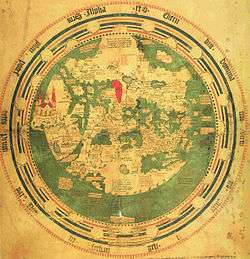Andreas Walsperger
Andreas Walsperger (born ca. 1415 in Radkersburg; time of death unknown) was a German cartographer of the 15th century. The son of a carpenter, he became a Benedictine monk at St. Peter's in Salzburg in 1434. He left the monastery in 1442. Little more is known about him except that in 1448/9[1] he created his map in Konstanz.

The map
The map of Andreas Walsperger is a Latin Mappa Mundi, atypical in its depiction of Africa and in its placing a large castle in China, where others including Fra Mauro's place their grand castle to the north. In Germany, the only other example of the type is the "Mappa mundi Ciziensis" from Zeitz.
The parchment measures 57.7 x 75 cm.
Ownership
In the sixteenth century, the Fugger family may have owned the map. In 1622, it was given to Pope Gregory XV by Maximilian I, Elector of Bavaria and is now held in the Vatican Library Palatina (Lat. 1362 B).
References
- he made the world-map for which he is remembered. It has elements in common with accounts of other maps no longer extant and with the better known worldmap of the Fra Mauro (1457) the most elaborate example of medieval Latin cartography remaining. "Archived copy". Archived from the original on October 8, 2007. Retrieved 2007-10-18.CS1 maint: archived copy as title (link)
Literature
- Paul Gallez: Walsperger and His Knowledge of the Patagonian Giants, 1448. In: Imago Mundi. The international journal for the history of cartography. Thaylor & Francis, London 1981 (Jg. 33), S. 91-93
- Karl-Heinz Meine: Zur Weltkarte des Andreas Walsperger, Konstanz 1448. In: Wolfgang Scharfe u.a. (Hrsg.): Kartenhistorisches Colloquium Bayreuth '82. Vorträge und Berichte. Dietrich Reimer Verlag, Berlin, 1983, ISBN 3-496-00692-7
External links
- http://www.bad-radkersburg-online.at/bad-radkersburg/pers3.htm zur Person des Andreas Walsberger
- http://www.henry-davis.com/MAPS/LMwebpages/245.html